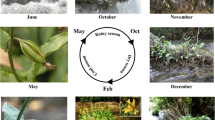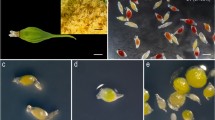Abstract
Paphiopedilum wardii Sumerh. is an endangered and rare terrestrial orchid threatened with extinction in the wild due to anthropogenic activities. Asymbiotic germination provides a useful way for ex situ conservation, for reintroduction in the wild, and for commercial demand. The 180-day seeds after pollination had highest germination rate with 65.33%, and 1/2MS supplemented with 0.5 mg l−1 NAA, 10% coconut water, and 1.0 g l−1 activated charcoal was a suitable medium. Hyponex N026 medium containing 1.0 mg l−1 NAA, 1.0 g l−1 peptone, 10% CW, and 1.0 g l−1 AC was most suitable for subculture of plantlets. Hyponex N016 medium containing 1.0 mg l−1 NAA, 1.0 g l−1 peptone, 100 g l−1 banana homogenate, and 1.0 g l−1 AC was suitable for plantlets’ growth in vitro. The plantlets 5 cm in height were transplanted in mixture media [2: 1: 1 (v/v) Zhijing stone for orchids/sieved peat/shattered fir bark]. Survival rate of 92.33% was obtained after 180 days in a greenhouse. 10,000 plantlets in vitro were obtained. We used the 1000 plantlets propagated in vitro to reintroduce into one habitat and two sites outside the species range. The 180-day transplanted seedlings were reintroduced into habitat at Gaoligong Mountain in Yunnan or alien forest habitats at Yangchun and Guangzhou in Guangdong, which had a higher survival percentage than 90-day or 360-day transplanted seedlings. About 2 years after transplantation, around 30% of plants that survived flowered from seedlings transplanted for 360 days at all three reintroduction locations. At Gaoligong Mountain, Lushui, 32% of flowering plants produced fruits and seeds.
Access provided by Autonomous University of Puebla. Download chapter PDF
Similar content being viewed by others
Keywords
- Paphiopedilum wardii Sumerh.
- Asymbiotic seed germination
- Implementation
- Reintroduction
- Post-planting monitoring
1 Introduction
Paphiopedilum wardii Sumerh. is an endangered and rare orchid distributed in Lushui county and northwest of Baoshan city, western Yunnan, China, and in Northern Myanmar (Cribb 1998; Liu et al. 2009). It flowers from December to March (Fig. 1). It grows in grassy and bushy places on wooded slope or forest margins along valleys at an elevation of 1200 and 2500 m (Fig. 2). It is a high-value ornamental plant evidenced by 92 combinations registered by the Royal Horticultural Society as of March 1, 2020. The wild populations of P. wardii are under the threat of extinction in the wild due to anthropogenic activities, and it is listed in the Convention on International Trade in Endangered Species of Wild Fauna and Flora (CITES) such that their trade is prohibited. It is now listed as Critically Endangered (CR) in the China Species Red List by the Chinese Government. However, owing to a large number of propagations in vitro and cultivation by South China Botanical Garden, which has been applied to commercial production, a substantial population exists outside wild habitats (Fig. 3).
2 Description of Reintroduction
2.1 Feasibility
We have studied the distribution, conservation status, ecological and biological characteristics, reproductive biology, tissue culture (Zeng et al. 2012), and horticulture of P. wardii since 2003 (Zeng et al. 2012). An effective system of propagation in vitro was established from asymbiotic seed germination. The 180-day seeds after pollination had highest germination rate with 65.33%, and 1/2MS supplemented with 0.5 mg l−1 NAA, 10% coconut water, and 1.0 g l−1 activated charcoal was a suitable medium. Hyponex N026 medium containing 1.0 mg l−1 NAA, 1.0 g l−1 peptone, 10% CW, and 1.0 g l−1 AC was most suitable for subculture of plantlets. Hyponex N016 medium containing 1.0 mg l−1 NAA, 1.0 g l−1 peptone, 100 g l−1 banana homogenate, and 1.0 g l−1 AC was suitable for plantlets’ growth in vitro. The plantlets 5 cm in height were transplanted in mixture media [2: 1: 1 (v/v) Zhijing stone for orchids/sieved peat/shattered fir bark]. Survival rate of 92.33%was obtained after 180 days in a greenhouse. One thousand plantlets were conducted in field establishment and habilitation at three locations: (1) Gaoligong Mountain (98° 20′ E, 25° 50’ N, habitat of P. wardii at an elevation of 1800 m) in Lushui county, Yunnan province; (2) Ehuangzhang Nature Reserve (111°30′E, 21°55’N, at an elevation of 295 m) in Yangchun, Guangdong province (Fig. 4); and (3) Huolu Mountain (113°38′E, 23°18’N, at an elevation of 85 m) in Guangzhou, Guangdong province in 2008. The plantlets were transplanted into the three locations in April 2008. (Zeng et al. 2012).
2.2 Implementation
During the acclimation period in three reintroduction locations, the plantlets were watered on days 1, 2, 7, 14, ,and 30, but were not watered thereafter. The quadrats were not fenced, fertilized, or mulched. We observed and monitored the survival rate and growth status semiannually.
2.3 Post-planting Monitoring
After reintroduction, we monitored the survival and growth status of all transplants in three locations from 2008 to 2017. About 1 year after transplanting, the highest survival rate was 65% at Ehuangzhang, Yangchun, from seedlings transplanted for 180 days, which was significantly higher than at the other two transplantation locations. About 2 years after transplantation, the highest survival rate was 60.33% at Ehuangzhang, Yangchun, from seedlings transplanted for 180 days, which was also significantly higher than other treatments. Around 30% of plants that survived flowered from seedlings transplanted for 360 days at all three reintroduction locations. At Gaoligong Mountain, Lushui (Fig. 5), 32% of flowering plants produced fruits and seeds; in contrast, although there were many flowering plants transplanted in the other two habitats, no plants produced fruits or seeds maybe because of pollinators.
3 Problems and Recommendations
-
There may be some remaining populations in other area on the China-Myanmar border, which need further investigate. The genetic diversity of all surviving P. wardii individuals should be analyzed by molecular tools to afford protection to all germplasm resources with different genetic diversities.
-
A new population established outside of the original habitat. The lack of effective pollinators could be a major limiting factor for reproductive success for full recovery of a self-sustaining population. In addition, the seeds could not successfully germinate because of lack of symbiotic fungi.
-
The best method for conservation of P. wardii is in situ preservation, which can only be resolved by legislation, public education, and suitable economic compensation. Ex situ conservation or reintroduction can be used as a helpful tool to conserve biodiversity, but it is difficult and expensive.
References
P. Cribb, The Genus Paphiopedilum, 2nd edn. (National History Publications, Malaysia Borneo, 1998)
Z.J. Liu, S.C. Chen, L.J. Chen, et al., The Genus Paphiopedilum in China (Science Press, Beijing, 2009), pp. 13–349
S.J. Zeng, K.L. Wu, J.A. Teixeira da Silva, et al., Asymbiotic seed germination, seedling development and reintroduction of Paphiopedilum wardii Sumerh. An endangered terrestrial orchid. Sci. Hortic. 138, 198–209 (2012)
Author information
Authors and Affiliations
Corresponding author
Editor information
Editors and Affiliations
Rights and permissions
Copyright information
© 2020 The Editor(s) (if applicable) and The Author(s), under exclusive license to Springer Nature Singapore Pte Ltd.
About this chapter
Cite this chapter
Zeng, S., Wu, K., Chen, Z., Duan, J. (2020). In Vitro Propagation and Reintroduction of Paphiopedilum wardii Sumerh.. In: Ren, H. (eds) Conservation and Reintroduction of Rare and Endangered Plants in China. Springer, Singapore. https://doi.org/10.1007/978-981-15-5301-1_17
Download citation
DOI: https://doi.org/10.1007/978-981-15-5301-1_17
Published:
Publisher Name: Springer, Singapore
Print ISBN: 978-981-15-5300-4
Online ISBN: 978-981-15-5301-1
eBook Packages: Biomedical and Life SciencesBiomedical and Life Sciences (R0)









